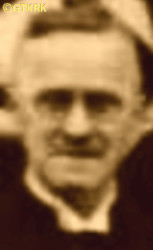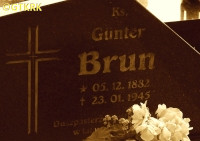Roman Catholic
St Sigismund parish
05-507 Słomczyn
85 Wiślana Str.
Konstancin deanery
Warsaw archdiocese, Poland
full list:
displayClick to display full list

searchClick to search full list by categories
wyświetlKliknij by wyświetlić pełną listę po polsku

szukajKliknij by przeszukać listę wg kategorii po polsku

Martyrology of the clergy — Poland
XX century (1914 – 1989)
personal data
surname
BRUN
surname
versions/aliases
BRAUN
forename(s)
Ginter
forename(s)
versions/aliases
Günter Benno
function
pastor
creed
Lutheran Church LUmore on
en.wikipedia.org
[access: 2014.09.21]
nationality
German
date and place
of death
23.01.1945

Ozimektoday: Ozimek gm., Opole pov., Opole voiv., Poland
more on
en.wikipedia.org
[access: 2021.12.18]
details of death
During Russian winter offensive of 1945 — so‐call Vistula–Odra operation — leading to the end of the World War II started by German and Russian invasion of Poland in 09.1919, right after Russian capture during very heavy fighting of Ozimek, shot on a village street by Russian soldiers, together with his housekeeper among others.
Russian soldier was supposed to ask him a question: „German?”; and after a brief „Yes” reply, shot him in the head.
cause of death
mass murder
perpetrators
Russians
sites and events
Mass rapes in 1945Click to display the description, Ribbentrop‐MolotovClick to display the description
date and place
of birth
05.11.1882

Głogówtoday: Głogów gm., Głogów pov., Lower Silesia voiv., Poland
more on
en.wikipedia.org
[access: 2010.08.11]
positions held
1929 – 1945
parish priest — Ozimektoday: Ozimek gm., Opole pov., Opole voiv., Poland
more on
en.wikipedia.org
[access: 2021.12.18] ⋄ John the Baprist LU parish — also: ministry in nearby villages: Lasy (Germ. Hüttendorf, today part of Ozimek), Jedlice, Mnichus
minister — Zawadzkietoday: Zawadzkie gm., Strzelce Opolskie pov., Opole voiv., Poland
more on
en.wikipedia.org
[access: 2023.04.02] ⋄ LU parish — commuting
c. 1919 – 1929
parish priest — Krzywintoday: Widuchowa gm., Gryfino pov., West Pomerania voiv., Poland
more on
en.wikipedia.org
[access: 2023.04.02] ⋄ LU parish
c. 1915 – c. 1919
parish priest — Kościelectoday: Krotoszyce gm., Legnica pov., Lower Silesia voiv., Poland
more on
en.wikipedia.org
[access: 2023.04.02] ⋄ LU parish
till c. 1914
minister — Gdańsktoday: Gdańsk city pov., Pomerania voiv., Poland
more on
en.wikipedia.org
[access: 2021.07.04] ⋄ Diakonissen Mutter und Krankenhaus (pl. Deaconess’ Maternal House and Hospital) — deputy parish priest
minister — Wrocławtoday: Wrocław city pov., Lower Silesia voiv., Poland
more on
en.wikipedia.org
[access: 2021.04.02] — apprentice
student — Wrocławtoday: Wrocław city pov., Lower Silesia voiv., Poland
more on
en.wikipedia.org
[access: 2021.04.02] ⋄ Evangelical Theology Department, University of Wrocław [i.e. University of Wrocław (since 1945) / Frederic Wilhelm University of Silesia (1911‐1945) / Royal University i.e. Breslau Academy (1816‐1911)] — graduation
student — Greifswaldtoday: Vorpommern‐Greifswald dist., Mecklenburg‐Vorpommern state, Germany
more on
en.wikipedia.org
[access: 2022.02.15] ⋄ Department of Theology, Alma Mater Gryphiswaldensis (Eng. University of Greifswald)
student — Wrocławtoday: Wrocław city pov., Lower Silesia voiv., Poland
more on
en.wikipedia.org
[access: 2021.04.02] ⋄ Evangelical Theology Department, University of Wrocław [i.e. University of Wrocław (since 1945) / Frederic Wilhelm University of Silesia (1911‐1945) / Royal University i.e. Breslau Academy (1816‐1911)]
from 1913
married — five children
others related
in death
GÓRECZKAClick to display biography Josefa (Sr Pelagia), HELDTClick to display biography Charles Henry, MASSOW vonClick to display biography Bertha, ONNASCHClick to display biography Frederick Albert, ONNASCHClick to display biography Frederick Charles Günter
sites and events
descriptions
Mass rapes in 1945: During capture in 1944‐1945 of pre‐war German territories and territories incorporated into Germany in 1939 after German invasion of Poland Russian soldiers committed mass, often multiple, rapes on mainly German, but also Polish, women. Up to 2 mln women might have been violated, from 8 to 80 or more years old. Many were murdered as a consequence. Rapes were prob. tolerated if not encouraged by Russian military and civilian NKVD commanders. (more on: en.wikipedia.orgClick to attempt to display webpage
[access: 2015.03.01])
Ribbentrop‐Molotov: Genocidal Russian‐German alliance pact between Russian leader Joseph Stalin and German leader Adolf Hitler signed on 23.08.1939 in Moscow by respective foreign ministers, Mr. Vyacheslav Molotov for Russia and Joachim von Ribbentrop for Germany. The pact sanctioned and was the direct cause of joint Russian and German invasion of Poland and the outbreak of the World War II in 09.1939. In a political sense, the pact was an attempt to restore the status quo ante before 1914, with one exception, namely the „commercial” exchange of the so‐called „Kingdom of Poland”, which in 1914 was part of the Russian Empire, fore Eastern Galicia (today's western Ukraine), in 1914 belonging to the Austro‐Hungarian Empire. Galicia, including Lviv, was to be taken over by the Russians, the „Kingdom of Poland” — under the name of the General Governorate — Germany. The resultant „war was one of the greatest calamities and dramas of humanity in history, for two atheistic and anti‐Christian ideologies — national and international socialism — rejected God and His fifth Decalogue commandment: Thou shall not kill!” (Abp Stanislav Gądecki, 01.09.2019). The decisions taken — backed up by the betrayal of the formal allies of Poland, France and Germany, which on 12.09.1939, at a joint conference in Abbeville, decided not to provide aid to attacked Poland and not to take military action against Germany (a clear breach of treaty obligations with Poland) — were on 28.09.1939 slightly altered and made more precise when a treaty on „German‐Russian boundaries and friendship” was agreed by the same murderous signatories. One of its findings was establishment of spheres of influence in Central and Eastern Europe and in consequence IV partition of Poland. In one of its secret annexes agreed, that: „the Signatories will not tolerate on its respective territories any Polish propaganda that affects the territory of the other Side. On their respective territories they will suppress all such propaganda and inform each other of the measures taken to accomplish it”. The agreements resulted in a series of meeting between two genocidal organization representing both sides — German Gestapo and Russian NKVD when coordination of efforts to exterminate Polish intelligentsia and Polish leading classes (in Germany called «Intelligenzaktion», in Russia took the form of Katyń massacres) where discussed. Resulted in deaths of hundreds of thousands of Polish intelligentsia, including thousands of priests presented here, and tens of millions of ordinary people,. The results of this Russian‐German pact lasted till 1989 and are still in evidence even today. (more on: en.wikipedia.orgClick to attempt to display webpage
[access: 2015.09.30])
sources
personal:
www.stolica.opole.plClick to attempt to display webpage
[access: 2013.05.19], muzeum-hutnictwa.euClick to attempt to display webpage
[access: 2023.04.02]
bibliographical:
„Opole Silesia clergy's martyrology during II World War”, Fr Andrew Hanich, Opole 2009
original images:
www.sdmp.plClick to attempt to display webpage
[access: 2013.06.11], commons.wikimedia.orgClick to attempt to display webpage
[access: 2020.09.28]
LETTER to CUSTODIAN/ADMINISTRATOR
If you have an Email client on your communicator/computer — such as Mozilla Thunderbird, Windows Mail or Microsoft Outlook, described at WikipediaPatrz:
en.wikipedia.org, among others — try the link below, please:
LETTER to CUSTODIAN/ADMINISTRATORClick and try to call your own Email client
If however you do not run such a client or the above link is not active please send an email to the Custodian/Administrator using your account — in your customary email/correspondence engine — at the following address:

giving the following as the subject:
MARTYROLOGY: BRUN Ginter
To return to the biography press below:
 Click to return to biography
Click to return to biography









